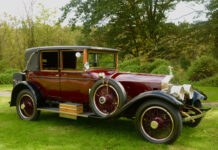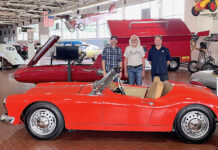By Jay Hirsch
In 1957, and the same for today, most new cars leave the factory on giant transport trucks. This is an industry unto itself. One of the pioneers in this business was Gene Cassaroll of Detroit.
During WWII Cassaroll had a contract with the government to transport huge bomber fuselages. For this work he devised a truck with two engines using mostly Dodge parts. From the use of two engines came the name Dual Motors.
Cassaroll had a vision of a personal luxury-type car for the American car market in the late 1950s, based loosely on the early 1950s show cars of Dodge, the Fire Arrow and Firebomb. Cassaroll contacted Ghia Auto Body works in Turin, Italy, to make this vision into reality. He hired Paul Farrago, from Detroit, to rework the Fire Arrow into the car that could hold some friends or family members. Farrago was an Italian-born mechanic-stylist-race-car-driver.
The cars were to be based on the Dodge chassis with a D-500 engine. The chassis were sent to Turin, where the main frame was cut according to the engineered specifications of Cassaroll.
The custom, hand-formed steel body was then welded onto the chassis, creating a single unit with much resistance to flexing. The use of steel was in contradiction to the normal custom bodies of aluminum that Ghia turned out. It is more difficult and time-consuming to work with and fabricate steel, the net result being a more costly car,
The 1954 Dodge Fire Arrow, which the Dual Ghia bears a strong resemblance to, was a two-seat show car with a small shelf area behind the front seats. The Dual Ghia was a longer car with the capability of carrying four passengers in comfort. The rear seats were not ornamental, but had full leg, hip and headroom, with the top up. The trunk was more than adequate for carrying luggage, whether for a weekend jaunt or a week’s vacation.
Unlike the standard Chrysler Corporation cars of 1957, the Dual Ghia did not have the push button transmission, but a floor-mounted, center-console PowerFlite. This arrangement eliminated some linkage, resulting in more off-the-line power and top-end punch when nailing pedal to metal. The Ghia did 0 to 60 mph in 8.6 seconds, 50 to 70 mph in 3.4 seconds and had a top end speed of 130 mph.
With its 315 V-8 cid/5.2-liter Hemi engine the car makes just enough noise to let you and anyone nearby know that this is no ordinary convertible. From a standstill there is enough torque to push you back in your seat. With that top tucked neatly behind the tonneau cover and the wind in your hair, there are more thrills than bugs on the grille.
The Dual Ghia at 203 inches was ten inches shorter than a 1957 Dodge, and about 200 pounds lighter, with less weight on the front wheels, giving the Dual Ghia better balance. The net result was that the Dual Ghia can be taken into corners almost like a sports car. The Dual Ghia was closer to a Corvette or Thunderbird in spirit than the standard “American Cruiser” of the 1950s. As for that handling, the Dual Ghia had torsion bar front suspension with coil springs and leaf springs in the rear.
To keep weight to a minimum, in addition to keeping the engine compartment clean and clutter free, power windows were not offered, nor were power steering and a power top. The top is so carefully balanced that one person can raise or lower it in about 30 seconds. The tonneau cover keeps it neatly hidden, and none of the lines of the car are disturbed when in place. The rear seat, advertised as “comfortably holding three,” is a bit of an advertising stretch. Two people would be comfortable, three people would be fine for a 15-minute ride. The excitement of being in the car would outweigh the discomfort of the person in the middle of the rear seat.
The engine-turned instrument panel is simple with easy-to-read dials. There is a big tachometer, pointer type gauges for oil pressure, temperature and generator readings, a depressed center steering wheel with a huge horn. All the dials have chrome rings surrounding them. This is a 1950s cruiser-type sports car made for Americans…well-off Americans. After the body of the cars were built on the Dodge chassis in Italy, they were shipped back to Detroit where the drivetrain and all accoutrements of the automobile were installed.
At a cost of $7,600 to $7,900, the person who bought a Dual Ghia did not want to know about “less-weight, engine clutter, etc.” By the time the Dual Ghias were ordered and sold, power steering and power windows were available on the cars. But the manual top remained.
The Dual Ghia became known as the “car of the stars,” as several celebrities of the time purchased them. Among them were Frank Sinatra, Peter Lawford, Debbie Reynolds, and tennis star Gussie Moran.
Detailing of the body was unusual for the era. The grille, windshield molding, doorsills, all the body trim were chrome plated solid brass. The engine and trunk compartments were edged in polished aluminum molding.
The car seen here in dark burgundy was one of those “celebrity cars,” having been bought new by Dean Martin. It had two owners since Martin and was always a West Coast car. It was restored by the third owner, who had a home in Palm Springs, Calif. Michael Schudroff, the current owner, acquired the car in 2008 when it was offered for sale.
Approximately 117 Dual-Ghia’s were built from 1956 to 1958. The Dual Ghia ranged in price from $7,600 when first introduced in early 1957 to $7,900 in late 1957, delivered to the West Coast.
The next-generation Dual Ghia, from 1960 to 1963, was simply called Ghia and received a minor face lift. The rear tail fin was eliminated and the parking lights were mounted inside of the grill, adjacent to the headlights. The front and rear bumpers became more slender.
The Dual Ghia is extremely comfortable, fast and distinctive. It is in good taste for the late 1950s, and for today also, with minimal amounts of chrome that have no function.
In Dell’s 1957 New Car guide, the final words on the Dual Ghia are: “We predict that this car will be the forerunner of many new ideas in fine cars.” •



